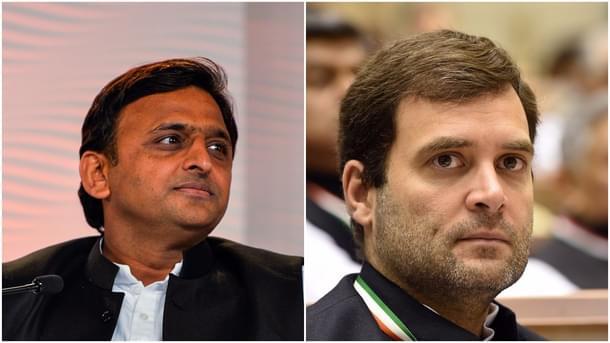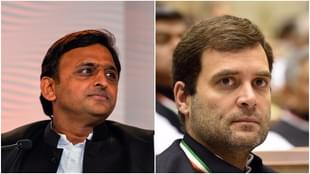Politics
SP-Congress Alliance In UP Polls: A Second Place Finish May Not Be A Bad Thing For BJP
Raghav Awasthi
Jan 22, 2017, 04:27 PM | Updated 04:27 PM IST
Save & read from anywhere!
Bookmark stories for easy access on any device or the Swarajya app.


As soon as Ghulam Nabi Azad announced that the upcoming Uttar Pradesh (UP) elections would be fought by the Congress party under the leadership of the incumbent Chief Minister Akhilesh Yadav, the mainstream media started telling us how this alliance would be a game-changing move and how the Bharatiya Janata Party (BJP) was staring at a redux of what happened in the Bihar polls of 2015. My take on whether this alliance would be able to replicate the success of the Mahagathbandhan in 2015 is slightly different. There is absolutely no doubt that had the Congress and the Samajwadi Party (SP) gone into this election without an alliance, they were staring at an almost inevitable defeat at the hands of the BJP.
The fact of the matter is that despite the high Muslim population (Supposedly captive voters of the SP) and all the talk of Akhilesh’s youthful charisma, the party has never crossed more than 30 per cent of the popular vote in the electoral history of UP. Even when it notched up its best performance in 2004 (Lok Sabha polls), its vote-share was just about 27 per cent. On the other hand, the BJP has consistently polled more than 35 per cent of the popular vote in the 1990s. In this view of the matter, it is perhaps a great move, in hindsight to have allied with the Congress and one must commend Akhilesh’s political nous in having reached out to party vice-president Rahul Gandhi and the rest of its leadership, despite the fact that his uncle and father had rebuffed the overtures of the grand old party earlier.
For its part, the Congress party’s vote share has seen a steady decline over the last two decades. In the Lok Sabha polls of 2009, it polled around 18.25 per cent of the ballot. The said figure dropped to about 12 per cent in 2012 (Vidhan Sabha) and finally settled at an all-time low of seven-and-a-half per cent in the 2014 Lok Sabha polls. The big question is whether this alliance can replicate the success of the Mahagathbandhan in 2015 which pipped the NDA’s vote by more than seven percentage points thereby sweeping the state and winning 179 seats to the NDA’s 54. There are, however, a few significant differences between Bihar and UP. In the latter state, the Elephant in the room, pun intended, is the Bahujan Samaj Party (BSP) – a party that polled almost 20 per cent of the popular vote even at the height of the Modi wave.
Let us assume for a moment that the share of the BSP remains constant. We shall return to it later. What Akhilesh needs to do is to ensure that there is a positive six per cent net gain for the Congress and the SP alliance and a 6 per cent or greater loss for the NDA while hoping that the latter bleeds some votes to the BSP as well. To put the enormity of the task that lies ahead of him in perspective, the combined vote share of the JDU, RJD and the Congress rose by just about four percentage points vis-à-vis Lok Sabha 2014. The NDA’s percentage, on the other hand, declined by just about four percentage points. Therefore, to reiterate a point that I have belaboured earlier if the BJP replicates Bihar in UP and holds on to 85 to 90 per cent of the voters, who voted for it in 2014, it wins. It is important to keep in mind that Nitish Kumar’s ratings even in 2015 were much higher than Akhilesh’s in 2017, despite all the efforts on the part of the media to prop him up as Narendra Modi’s latest challenger.
The biggest headache for the BJP is that it goes into the contest without a Chief Ministerial face. However, it can draw solace from the fact that it retained most of its vote in Bihar without a Chief Ministerial face either.
The other factor that can upset all equations is demonetisation. The jury is still out on whether it has the potential to produce electoral dividends in favour of the BJP. Whatever may be the advantages of the same in economic terms, in my considered opinion, from a purely electoral perspective, it makes precious little sense as the BJP’s popularity was at an all-time high at around the time when the surgical strikes in Pakistan Occupied Kashmir were conducted in September.
Now, if the performance of the BJP declines even slightly, demonetisation shall surely be blamed for the same. It would not be an exaggeration to say that this election, which was the BJP’s to lose has now become a race that is almost too close to comfort. On the other hand, there is a body of opinion that tells us that demonetisation has created a groundswell of support for the BJP in sections of the society that had hitherto not been supporters. The jury is still out. My two bit is that even though it is a politically courageous move on the part of the Prime Minister, the party is surely going to pay for it at the hustings. One can just hope that the price to be paid is not too dear!
As far as the BSP is concerned, the wheels are surely coming off. The Muslim vote that the BSP had been courting seems to have shifted decisively to the SP and the Congress. The Jatav-Dalits alone cannot propel Behenji to power again. For the remaining duration of the campaign, the BJP should pay some attention to the core voters of the BSP who have been at the receiving end of caste oppression as well as Gundagardi over the past five years. A small swing in the BJP’s favour might make the difference between a defeat and a victory.
Last, but not the least, a second position finish in UP for the BJP might not be such a bad thing after all. Except for Mulayam Singh Yadav’s 35 seats in 2004, no other ruling party from UP has been able to attain pole position in the General Election. It is much better for the BJP to contest 2019 with a relatively fresh slate than to be burdened with double anti-incumbency at the Central as well as State level.
Raghav Awasthi is a lawyer based in Delhi and a member of the BJP MCD election campaign committee.





